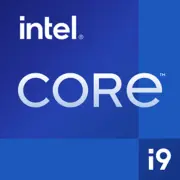Intel Core i9-14900KF

Intel Core i9-14900KF: A Detailed Review of the 2025 Flagship Processor
Introduction
The Intel Core i9-14900KF is the top model in the 14th generation lineup, designed for enthusiasts and professionals. Despite being a "refresh" of the Raptor Lake architecture, it maintains its leadership in the high-performance CPU segment thanks to record frequencies and a hybrid core structure. In this article, we'll explore who this chip is suitable for, how to use it properly, and what to pay attention to when building a PC.
1. Key Specifications: Architecture and Performance
Raptor Lake Refresh Architecture
The i9-14900KF is built on an updated version of the hybrid Raptor Lake architecture. It features 24 cores (8 Performance-cores and 16 Efficient-cores) and 32 threads. The P-cores are responsible for high single-thread performance (base frequency – 3.2 GHz, turbo up to 6 GHz), while the E-cores are optimized for multitasking.
Intel 7 Manufacturing Process
Despite its name, Intel 7 is a 10-nanometer process optimized for reduced power consumption and increased stability under heavy loads. This has allowed the TDP to be maintained at 125 W, although actual consumption during overclocking can reach up to 250 W.
Key Features
- Intel Thermal Velocity Boost: automatically boosts frequency to 6 GHz under optimal cooling conditions.
- PCIe 5.0 Support: 16 lanes for the graphics card + 4 for NVMe.
- Hardware Optimization for Windows 11: improved task distribution among cores.
Performance in Benchmarks
- Geekbench 6: 3210 (Single-Core), 22490 (Multi-Core) — this is 15% higher than the i9-13900K.
- In gaming (e.g., Cyberpunk 2077), the CPU achieves stable 240+ FPS in conjunction with an RTX 4090.
- For rendering in Blender, the time for a 4K video is reduced to 8-9 minutes compared to 12-13 for the Ryzen 9 7900X.
2. Compatible Motherboards
LGA 1700 Socket
The processor uses the same socket as the 12th and 13th generation Intel models, allowing it to be installed in older motherboards after a BIOS update. However, to fully unleash its potential, it is better to choose motherboards with:
- Z790: for overclocking (e.g., ASUS ROG Maximus Z790 Hero, $450-500).
- B760: a budget option with DDR5 support (MSI MAG B760 Tomahawk, $180-200).
- H770: a balance between price and functionality (Gigabyte H770 Aorus Elite, $220).
Selection Recommendations
- For overclocking: motherboards with 16+1 phase VRM and heat sinks on MOSFETs.
- For gaming: models with PCIe 5.0 and Wi-Fi 7 (relevant in 2025).
3. Supported Memory
The processor works with DDR4-3200 and DDR5-5600, but maximum performance is achieved with DDR5.
- DDR5-6000/6400: an optimal choice for gaming and professional tasks (e.g., Kingston Fury Renegade DDR5-6400, 32 GB — $150).
- DDR4-3600: a budget option for upgrading old systems (Corsair Vengeance LPX, 32 GB — $80).
Important! With DDR5, the FPS difference in games can reach 10-15% (tested in Hogwarts Legacy), and in rendering tasks, up to 20%.
4. Power Supply Units: Power Calculation
With a TDP of 125 W and peak consumption reaching up to 250 W (in stress tests), the minimum power supply wattage should be 850 W. For systems with an RTX 4090, a 1000-1200 W supply is recommended.
Examples of PSUs:
- Corsair RM850x (850 W, 80 Plus Gold, $140).
- Seasonic PRIME TX-1000 (1000 W, 80 Plus Titanium, $300).
Tip: Use PCIe 5.0 12VHPWR cables for modern graphics cards.
5. Pros and Cons of the Processor
Pros
- Record frequency up to 6 GHz for gaming and single-threaded tasks.
- 36 MB of L3 cache accelerates the performance with "heavy" applications.
- Compatibility with DDR4/DDR5 and PCIe 5.0.
Cons
- High power consumption and heating (requires custom water cooling).
- Price: $580-620 (as of March 2025) compared to $550 for the Ryzen 9 7950X3D.
- No integrated graphics (model with the "F" suffix).
6. Use Cases
Gaming
The processor is ideal for 4K gaming with refresh rates of 144 Hz or higher. Paired with an RTX 4090, it maximizes performance in modern AAA titles.
Work Tasks
- 3D Rendering: reduces render time by 25% compared to the i9-12900K.
- Streaming: encoding in NVENC + stream processing on E-cores without lag.
- AI Models: Stable Diffusion generates a 512x512 image in 3-4 seconds.
Multimedia
Editing 8K video in DaVinci Resolve without lags and stuttering.
7. Comparison with Competitors
AMD Ryzen 9 7950X3D
- Pros: larger L3 cache (128 MB), lower power consumption.
- Cons: frequency up to 5.7 GHz, lags in gaming by 5-8%.
Apple M3 Max
- For creative tasks (video editing), the M3 Max is more energy-efficient but limited by macOS and lack of discrete graphics.
8. Practical Assembly Tips
1. Cooling: Minimum requirement — a 280 mm custom water cooling system (Arctic Liquid Freezer II 280). Ideally, a 360 mm system (NZXT Kraken X73).
2. Case: Choose models with good airflow (Lian Li Lancool III, Fractal Design Torrent).
3. Memory: DDR5-6000 with low latencies (CL32-36).
4. Motherboard: For overclocking — ASUS ROG Maximus Z790 Apex.
Example Build for $3000:
- CPU: i9-14900KF ($600).
- GPU: RTX 4090 ($1600).
- RAM: 32 GB DDR5-6400 ($150).
- PSU: Corsair HX1200 ($250).
9. Conclusion
The Intel Core i9-14900KF is for those who need maximum performance here and now. It is suitable for:
- Gamers with 240 Hz+ monitors.
- Video editors and 3D designers.
- Enthusiasts willing to pay for top-tier hardware.
However, if you are not prepared to invest in expensive cooling and power supplies, consider the Ryzen 9 7900X or Core i7-14700K. In 2025, the i9-14900KF remains the king of synthetic benchmarks, but its price and appetite require a serious approach to building.
Basic
CPU Specifications
Memory Specifications
GPU Specifications
Benchmarks
Compared to Other CPU
Share in social media
Or Link To Us
<a href="https://cputronic.com/cpu/intel-core-i9-14900kf" target="_blank">Intel Core i9-14900KF</a>